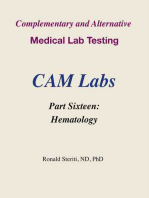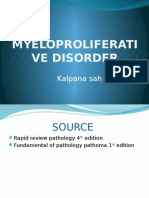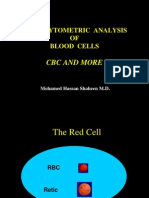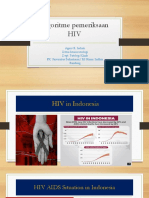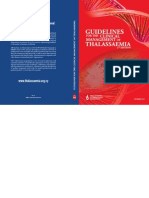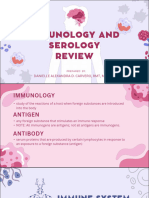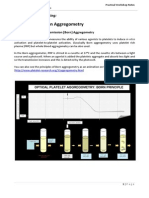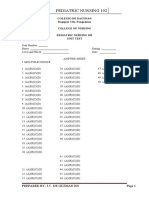Thalassemia
Thalassemia
Uploaded by
Shella NovitaCopyright:
Available Formats
Thalassemia
Thalassemia
Uploaded by
Shella NovitaOriginal Description:
Copyright
Available Formats
Share this document
Did you find this document useful?
Is this content inappropriate?
Copyright:
Available Formats
Thalassemia
Thalassemia
Uploaded by
Shella NovitaCopyright:
Available Formats
1
THALASSEMIA
HEMATO-ONCOLOGY DIVISION
PEDIATRIC DEPARTEMENT
MEDICAL SCHOOL
UNIVERSITY OF NORTH SUMATERA
2
3
4
5
HEMOGLOBINOPATHIES
CLASSIFIED INTO TWO MAJOR GROUPS
1. THALASSEMIAS
Quantitative deficiencies in the
production of globin chains
2. HEMOGLOBINS DISORDER
Structural abnormalities of globin chains
6
CLASSIFICATION OF THE COMMON
THALASSEMIAS AND RELATED DISORDERS
-Thalassemia
+
o
- Thalassemia
i
+
Hb Lepore thalassemia
(
)
o
(
A
)
o
- Thalassemia
()
o
- Thalassemia
-or- Thalassemia associated with -chain variants
Hb S -Thalassemia
Hb E -Thalassemia
many others
7
CLASSIFICATION OF THE COMMON
THALASSEMIAS AND RELATED DISORDERS
-Thalassemia
+
(deletion)
+
(non-deletion)
o
Hereditary persistence of HbF
Deletion
Non-deletion
A
+ G
+
Unlike to -globin gene cluster
8
3
- THALASSEMIA
DIAGNOSE :
African, Mediteranian, Middle Eastern,
Chinese, or Southeast Asian ancestry
Microcytic, hypochromic anemia of
variable severity
Hemoglobin Barts detected by neonatal
screening
9
PATOPHYSIOLOGY
10
USUAL
GENOTYP
ES
-
GENE
NUMBE
R
CLINICAL
FEATURE
S
HEMOGLOBIN
ELECTROPHORESIS
BIRTH > 6 MO
/ 4 NORMAL NORMAL NORMAL
- / 3
SILENT
CARRIER
0 3% Hb Barts NORMAL
-- / or
- / -
2
- THAL
TRAIT
2 10% Hb Barts NORMAL
-- / - 1
Hb H
DISEASE
15 30% Hb
Barts
Hb H
PRESENT
-- / -- 0
FETAL
HYDROP
S
> 75% Hb Bart,s -
Table 1. The - thalassemias
11
Thalassemia _alpha
12
TREATMENT
-thalassemia trait require no treatment
Hb H disease should receive folic acid
avoid the same oxidant drugs
Transfusions may be required
Splenectomy
Genetic counseling and prenatal diagnosis
13
-THALASSEMIA
Essentials of diagnosis & typical features
-thalassemia minor
- mild hypochromic microcytic anemia
Haemoglobi 90-110g/l
Mean cell volume 50-70 fl
mean corpuscular haemoglobin 20-22 pq
- no clinical features, patient asymptomatic
- often diagnosed on routine blood count
- raised Hb A
2
level
14
-Thalassemia major :
severe anemia
Blood film
- pronounced variation in red cell size and shape
- pale (hypochromic) red cells
- target cells
- basophillic stippling
- nucleated red cells
- moderately raised reticulocyte count
infants are well at birth but develop anemia in first
few months of life when switch occurs from to
globin chains
progressive splenomegaly; iron loading; proneness to
infection
15
16
SCREENING
Peripheral blood stain
Mean corpuscular volume (MCV) value
and MCH value
Mentzer index
RDW index
Hb-electroforese
17
PRENATAL DIAGNOSIS
If mother suffered thalassemia
DNA analysis by CVS (chorion vilus
sampling) at 9-12
th
week of gestation
PCR rapid detection of mutation
18
Thalassemia_beta
19
Thalassemia minor
20
Thalassemia major
21
22
thalassemia
Hb elektroforese
23
TREATMENT
red cell transfusion : PRC, neocyte
infective complication
- viral hepatitis
- Yersinia infection
splenectomy
chelation theraphy : desferrioxamine
if serum ferritin 1500 g or got
transfusion 10-20 x
Dose of desferrioxamine :20-40 mg/kgBW
for children
24
INFECTIONS IN THALASSAEMIA MAJOR
The second commonest cause of death in thalassaemia major
The reasons for infection are :
Transmission by blood transfusion
Altered host immunity due to :
Hypersplenisme
Iron overload and chelation therapy
25
HEPATITIS C VIRUS
RNA virus was first characterized in 1989
Antibodies after infection are strain specific
Preventive : careful selection of voluntary donors and
blood donor screening
The severity of hep.C greater because of:
Concomitant iron overload
Other concurrent viral infections ( HBV, HIV )
26
COMPLICATIONS OF INFECTION
Acute infection
Chronic infection
Cirrhosis
End-stage liver disease
Hepatocellular carcinoma (HCC)
Non hepatic manifestations : arthritis, keratoconjunctivitis
sicca, lichen planus, glomerulonephritis, and vasculitis.
Essential mixed cryoglobulinemia (EMC)
Porphyria cutanea tarda
27
DIAGNOSIS AND MONITORING
Antibody Testing
HCV RNA
Detected by PCR
Moct reliable indicator of viral activity
Precedes sALT elevation in acute or recurrent cases by
2-10 weeks
Anti HCV
Detected by RIBA
Liver biopsy
Determined of the extend of liver disease
Assesment liver tissue iron load
Monitoring progression and response to antiviral virus
28
TREATMENT
Selection of patients for therapy
Confirmed presence of HCV-RNA
Moderate to high sALT level
Abnormal liver histology
Presence of persistent HCV RNA sufficient to consider
treatment
Response to treatment
Biochemical (sALT)
Virological (HCV-RNA)
The timing of the above response
29
Treatment regiment : Interferone
Dose: 3 MU sc or IM , 3 times daily
Duration : 12 24 months
Side effect : flu like symptoms, insomnia, cognitive
and mood changes, neutropenia, thrombocytopenia,
hypothyroidism, heart failure
Monitoring side effect : thyroid function, blood
counts
30
RE-TREATMENT
if non response, relaps, partial response, and
breakthrough patient
Re-treatment options :
Recombinant interferon with Ribavirin for 6 months
The same drug with longer periode (12-24 months),
or higher dose for 6-12 months
A different interferon
Side effect : haemolysis in thalassaemia patients
31
Management of liver disease is important for :
Children
Cirrhosis
Immunosuppresed patients
Pregnancy
Acute hepatitis C
PREVENTION
No vaccine or immunoglobulin
Safe sexual practices
Avoiding sharing toothbrushes, razors, eating utensils.
32
HEPATITIS B VIRUS
In thalassaemia major : HBsAg positive varies from <1%
to >20%, and past infection rates range from <10-70%
HBV marker :
Acute : HBsAg (4-5 mo), HBeAg (1-3 mo)
Chronic : HBsAg, anti - HBc
Previous infection or vaccination : antibody for HBsAg,
with anti HBc (prev. inf), or without anti
HBc(vaccination)
33
Natural history :
Acute hepatitis : incubation periode 4-20 weeks
Progression to chronic hepatitis B : 5-10% in healthy
adults, and 90% in neonates
Cirrhosis : 1-2,2 % per year
Hepatocellular carcinoma
PREVENTION
Hep B Vaccine: 3 times (at 0, 1 and 6 mo), and booster
Hep B vaccine and HBIg to neonates delivery by a carrier
34
TREATMENT
Lamivudin (3 TC)
Recombinant -interferon
HUMAN IMMUNODEFICIENCY VIRUS (HIV)
Prevalence in thalassaemia : <1% - > 20%
Management :
Antiretroviral therapy
Erythropoetin
Caution for drug that can exacerbate neutropenia
Control of iron overload
splenectomy
35
CYTOMEGALOVIRUS
Treatment : Bone Marrow Transplantation
Leucoreduction of blood product
PARVOVIRUS B 19
May cause transient aplastic crisis
Characterized by :
A fall in Hb 2 g/dl or more
Reticulocytes < 0,2%
Absence of red blood precursors in the bone marrow
B 19 DNA viraemia reach up to 10
14
virious/ml
Transient drop lymphocytes, neutrophils, platelet
36
Treatment :
Blood transfusion : acute B19 crises
Immunoglobulin administrations : chronics illness
MALARIA AND CHAGAS DISEASE
Plasmodium sp and Trypanosoma cruzii remain viable
in refrigerator blood components at least 2 weeks
Prevent transmission through blood product.
37
IRON ASSOCIATED INFECTION
Bacterial Infections : Yersinia anterocolica, Klebsiella sp,
E. colli, Strept. Pneumonia, Pseudomonas aeroginosa,
Listeria monocytogenes
YERSINIA ENTEROCOLITICA
Lives in an iron rich environment
Transmitted by : ingested of contaminated food, meat,
water.
Mortality rate among recipient > 50%
38
Clinical manifestations :
Severe in thalassaemia
Fever, abvdominal pain, diarrhoea, or vomiting
Athralgia, skin rashes
Complications : abdominal abscess, nephritis, splenic
abscess
Laboratory diagnosis
Culture from stool, blood, samples of affected tissue (e.g.
gut, lymph node)
Serial IgG titres
39
TREATMENT
Stop iron chelation therapy immediately
Obtain suitable laboratory samples
Antibiotic treatment
Ciprofloxacin
Gentamycin
Chloramphenicol
Trimethoprim-sulfomethoxazole
40
Table 1. Clinical and laboratory evaluation checklist
Monthly
CBC
Every 3 months
serum feritin
clinical chemistry
glucose
urate
creatinine
iron
TIBC
alk. Phosphatase
- GT
ALT/GPT
AST/GOT
LDH
Every 6 months
cardiac evaluations
cardiac echo
EKG
heart chamber
dimensions
systolic function
diastolic function
Fractional shortening
41
Table 1. Clinical and laboratory evaluation checklist
Yearly
Virology
Hep C panel ( anti-
HCV, anti-HCV RIBA )
Hep B panel (HBsAg,
anti HBs, anti HBc Ig)
anti HIV 1+ 2
liver biopsi
endocrine function
evaluation
free T
4
and TSH
parathyroid hormone
FSH
LH
testosterone
estradiol
DHEA-S
fasting a.m. cortisol
OGTT
bone age and density
zinc, cooper,
selenium,
Vit C, vit E
42
Table 1. Clinical and laboratory evaluation checklist
Yearly
complete physical exam
opthalmology
examination
audiology examination
As Indicated
24 hour Holter monitor
Cardiac stress test ( EST)
anti HBc Ig M
anti HBe
HBeAg
anti HDV
HCV - RNA
43
INSERTION OF
DESFEROXAMINE
44
4
post splenectomy
45
You might also like
- NLE EssenceDocument59 pagesNLE EssenceFatima Shah100% (1)
- Acute Leukaemia-Update: DR Niranjan N. RathodDocument89 pagesAcute Leukaemia-Update: DR Niranjan N. RathodratanNo ratings yet
- Troubleshooting in CXMDocument3 pagesTroubleshooting in CXMquerokeropi100% (1)
- Diagnosis of AnemiaDocument14 pagesDiagnosis of AnemiaAnggie AnggriyanaNo ratings yet
- Final Exam QuizDocument75 pagesFinal Exam QuizLauren Napoli0% (1)
- Fast Facts: Myelofibrosis: Reviewed by Professor Ruben A. MesaFrom EverandFast Facts: Myelofibrosis: Reviewed by Professor Ruben A. MesaNo ratings yet
- Complementary and Alternative Medical Lab Testing Part 16: HematologyFrom EverandComplementary and Alternative Medical Lab Testing Part 16: HematologyNo ratings yet
- The Many Faces of Monoclonal GammopathiesDocument44 pagesThe Many Faces of Monoclonal GammopathiesimagigatoNo ratings yet
- MyelomaDocument40 pagesMyelomaHula HulahulagNo ratings yet
- Immature GranulocytesDocument10 pagesImmature Granulocytespieterinpretoria391No ratings yet
- HemoglobinopatiDocument40 pagesHemoglobinopatiHenni Junita Siregar SorminNo ratings yet
- Leucodepletion Filter PDFDocument29 pagesLeucodepletion Filter PDFmukeshNo ratings yet
- Plasma Cell NeoplasmsDocument36 pagesPlasma Cell Neoplasmsdrafq2000No ratings yet
- Platelet IndicesDocument17 pagesPlatelet IndicesNarendra Bhattarai50% (2)
- Plasma Cell DyscrasiasDocument21 pagesPlasma Cell DyscrasiasJubril ZipamohNo ratings yet
- Pancytopenia As Initial Presentation of Acute Lymphoblastic Leukemia and Its Associationwith Bone MarrowresponseDocument6 pagesPancytopenia As Initial Presentation of Acute Lymphoblastic Leukemia and Its Associationwith Bone MarrowresponseIJAR JOURNALNo ratings yet
- MDSDocument46 pagesMDSFesti Mada HelmiNo ratings yet
- Para Protein Emi ADocument14 pagesPara Protein Emi AMohamoud MohamedNo ratings yet
- Acute Myelogenous LeukaemiaDocument72 pagesAcute Myelogenous LeukaemiaHan KethyanethNo ratings yet
- Multiple MyelomaDocument17 pagesMultiple MyelomaAhmed AbouelwafaNo ratings yet
- Webinar INAEQAS 27062020. Adhi K. Sugianli, DR., SPPK (K), M.Kes. How To Read The Gram Panel-1Document20 pagesWebinar INAEQAS 27062020. Adhi K. Sugianli, DR., SPPK (K), M.Kes. How To Read The Gram Panel-1Rini WidyantariNo ratings yet
- Tumor Markeri - Eng PDFDocument79 pagesTumor Markeri - Eng PDFdr_4uNo ratings yet
- Myeloproliferative DisorderDocument36 pagesMyeloproliferative DisorderKalpana ShahNo ratings yet
- Hema Part 3 Final PDFDocument188 pagesHema Part 3 Final PDFH.B.ANo ratings yet
- Multiple Myeloma: Presented By: DR - Ramesh Kumar Guide:-Dr. O.P. Meena SirDocument65 pagesMultiple Myeloma: Presented By: DR - Ramesh Kumar Guide:-Dr. O.P. Meena Sirvikash meenaNo ratings yet
- LMA Van Der Velden PDFDocument88 pagesLMA Van Der Velden PDFKarla Novoa PérezNo ratings yet
- Clinical Pathology Med School, Padjadjaran UniversityDocument38 pagesClinical Pathology Med School, Padjadjaran UniversityJenadi BinartoNo ratings yet
- Portal Vein ThrombosisDocument23 pagesPortal Vein ThrombosisJuan José Ruiz CastilloNo ratings yet
- Flow Cytometric Analysis o Blood CellsDocument82 pagesFlow Cytometric Analysis o Blood CellsMaysa ShaheenNo ratings yet
- DR - Agus. Current Diag and Class of Hematological Malig DR Agus FinalDocument46 pagesDR - Agus. Current Diag and Class of Hematological Malig DR Agus Finalbudi darmantaNo ratings yet
- Laboratory Testing For Cryoglobulins: Test of The MonthDocument3 pagesLaboratory Testing For Cryoglobulins: Test of The MonthDAWOODNo ratings yet
- Bioline Rapid. Urinalysis Test PDFDocument34 pagesBioline Rapid. Urinalysis Test PDFGail IbanezNo ratings yet
- HepatitisDocument46 pagesHepatitisGusti Tirtha Drag JrNo ratings yet
- Monoclonal GammopathiesDocument70 pagesMonoclonal GammopathiesElisa Lincă100% (2)
- Haematology: Questions&AnswersDocument87 pagesHaematology: Questions&AnswersCielNo ratings yet
- Prenatal Screening: HM Sulchan Sofoewan Divisi Feto-Maternal Bagian Obstetri Dan Ginekologi FK UGMDocument54 pagesPrenatal Screening: HM Sulchan Sofoewan Divisi Feto-Maternal Bagian Obstetri Dan Ginekologi FK UGMTahta PambudiNo ratings yet
- Acinetobacter Baumannii by Gemechis DejeneDocument36 pagesAcinetobacter Baumannii by Gemechis DejeneGemechis DejeneNo ratings yet
- Acute Promyelocytic LeukemiaDocument46 pagesAcute Promyelocytic LeukemiaKartthik ShanmugamNo ratings yet
- Guidelines For Transfusion and Immunohaematology Laboratory PracticeDocument71 pagesGuidelines For Transfusion and Immunohaematology Laboratory PracticeKraken UrNo ratings yet
- Algoritma Tes HIVDocument31 pagesAlgoritma Tes HIVyurdiansyahNo ratings yet
- New Red Blood Cell and Reticulocyte Parameters and Reference Values For Healthy Individuals and in Chronic Kidney Disease.Document8 pagesNew Red Blood Cell and Reticulocyte Parameters and Reference Values For Healthy Individuals and in Chronic Kidney Disease.Alberto MarcosNo ratings yet
- I How I Treat Hypereosinophilic SyndromesDocument10 pagesI How I Treat Hypereosinophilic SyndromesCesia ConstanzaNo ratings yet
- Guidelines For The Clinical Management of ThalassemiaDocument205 pagesGuidelines For The Clinical Management of ThalassemiaAmalia Muchammad BafagihNo ratings yet
- CBC Part 3 - RBC Morphology & PlateletsDocument67 pagesCBC Part 3 - RBC Morphology & PlateletsTshwarelo LegodiNo ratings yet
- Antigen Antibody ReactionsDocument72 pagesAntigen Antibody Reactionskritimahajan1989100% (1)
- BCCA Febrile Neutropenia GuidelinesDocument2 pagesBCCA Febrile Neutropenia GuidelinesdenokayuMRNo ratings yet
- HPLC Vs HB ElectrophoresisDocument10 pagesHPLC Vs HB ElectrophoresisRajeev Rajeshuni100% (1)
- Immunology and Serology Review 2023Document105 pagesImmunology and Serology Review 2023Ronelene GatoNo ratings yet
- Hematology Reference Values in Indonesian ChildrenDocument16 pagesHematology Reference Values in Indonesian ChildrenRini WidyantariNo ratings yet
- Myeloproliferative Disorders (Bhs Inggris)Document57 pagesMyeloproliferative Disorders (Bhs Inggris)Denny DedenNo ratings yet
- Chapter 12 - Leukocyte DevelopmentDocument16 pagesChapter 12 - Leukocyte DevelopmentAira Usi100% (1)
- Atlas Leukemia 1Document75 pagesAtlas Leukemia 1Dyah Rahayu SawitriNo ratings yet
- Prepared by Suzette B. Doctolero: Acinetobacter, Stenotrophomonas, andDocument16 pagesPrepared by Suzette B. Doctolero: Acinetobacter, Stenotrophomonas, andPojangNo ratings yet
- Additional Notes - Light Transmission Aggregometry NotesDocument7 pagesAdditional Notes - Light Transmission Aggregometry NotesAndrej TerzicNo ratings yet
- Plasmodium KnowlesiDocument21 pagesPlasmodium KnowlesiStanley S100% (1)
- A Pattern Based Approach To Nodal Lymphoma: The Critical Role of HistologyDocument55 pagesA Pattern Based Approach To Nodal Lymphoma: The Critical Role of Histologylazy19No ratings yet
- Final Exam Pediatric: A B C D E F GDocument6 pagesFinal Exam Pediatric: A B C D E F GDaham MothanaNo ratings yet
- Tab9 PDFDocument7 pagesTab9 PDFGokul GoNo ratings yet
- 450 1169 1 PB PDFDocument9 pages450 1169 1 PB PDFYosua Butar ButarNo ratings yet
- Case Report Pediatric Von&JepDocument23 pagesCase Report Pediatric Von&JepFarizan NurmushoffaNo ratings yet
- Anemia PPT-1 1Document29 pagesAnemia PPT-1 1haida hamzaNo ratings yet
- Sebia's Capillary Electrophoresis - SOPDocument20 pagesSebia's Capillary Electrophoresis - SOPSamrat Mitra100% (1)
- Pedia 102 Quiz 2 SemifinalsDocument19 pagesPedia 102 Quiz 2 Semifinalsquidditch07100% (1)
- Decent Work Employment & Transcultural Nursing SAS Session 16Document12 pagesDecent Work Employment & Transcultural Nursing SAS Session 16King NavsunNo ratings yet
- Atlas of Pediatric Peripheral Blood Smears PDFDocument52 pagesAtlas of Pediatric Peripheral Blood Smears PDFSuzy_89100% (2)
- AnemiaDocument11 pagesAnemiadewiq_wahyuNo ratings yet
- Analyzing Pedigrees - HomeworkDocument5 pagesAnalyzing Pedigrees - Homeworkzhonglis.sonNo ratings yet
- Iron Bioavailability and Dietary Reference ValuesDocument7 pagesIron Bioavailability and Dietary Reference ValuesSakarias PanjaitanNo ratings yet
- Dr. Pradeep Daniel Gainneos .R PG Student Dept. of PedodonticsDocument130 pagesDr. Pradeep Daniel Gainneos .R PG Student Dept. of PedodonticsPradeepDanielGainneos0% (1)
- 1 Hemoglobinopathies BookDocument26 pages1 Hemoglobinopathies BookRhoda Lom-ocNo ratings yet
- A Review On Anaemia - Types, Causes, Symptoms and Their TreatmentsDocument9 pagesA Review On Anaemia - Types, Causes, Symptoms and Their TreatmentsCindy AnggraeniNo ratings yet
- Questionpaper Unit16BI01 January2011Document24 pagesQuestionpaper Unit16BI01 January2011malak2852006No ratings yet
- MGD Eta1 Revision: Coagulation Cascade, Haemoglobinopathies & Chromosomal AbnormalitiesDocument16 pagesMGD Eta1 Revision: Coagulation Cascade, Haemoglobinopathies & Chromosomal AbnormalitiesAdiShineNo ratings yet
- GeneticTestPdf 6538 PDFDocument21 pagesGeneticTestPdf 6538 PDFMarianaBBazanNo ratings yet
- Hematology 1Document64 pagesHematology 1Kervy Jay AgraviadorNo ratings yet
- Pucat Dan Anemia Pada AnakDocument21 pagesPucat Dan Anemia Pada AnakHerry WaraNo ratings yet
- What Is Thalassemia PDFDocument4 pagesWhat Is Thalassemia PDFexamman123No ratings yet
- Chapter 30Document26 pagesChapter 30Nurse UtopiaNo ratings yet
- MCQ of HematologyDocument22 pagesMCQ of Hematologydrafq200063% (8)
- HB Q INDIADocument5 pagesHB Q INDIAcinema SemiramisNo ratings yet
- Patient Education - Beta Thalassemia (The Basics) - UpToDateDocument6 pagesPatient Education - Beta Thalassemia (The Basics) - UpToDatesushi37No ratings yet
- Dr. Jawale Resume 2014Document15 pagesDr. Jawale Resume 2014Dr. Jawale Chetan S.No ratings yet
- 001assessment Exam ImmunohemaDocument25 pages001assessment Exam ImmunohemaFrankenstein MelancholyNo ratings yet









